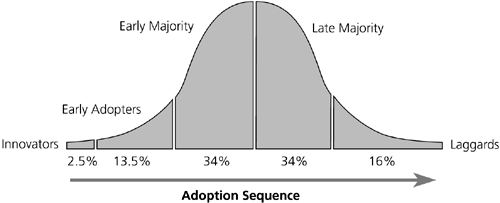Diffusion of Innovation
| The answer to that question is both easier and harder than you might think. The way in which innovations are diffused into common practice has been studied extensively. The seminal work on technology transfer is Everett M. Rogers's Diffusion of Innovations, which was originally published in 1962.[20] In the fourth edition, published in 1995, Rogers comments that more than 3,500 books and articles about diffusion were published between his first edition and his fourth. Rogers maps out a description of how innovations are adopted based on categorization of the adopters. The adopters include Innovators, Early Adopters, Early Majority, Late Majority, and Laggards. Figure 21-1 shows both the relative sizes of these groups and the sequence in which they adopt innovations. Figure 21-1. Innovations are diffused over time. The different groups that adopt an innovation have different needs and use different criteria to evaluate it.Source: Adapted from Diffusion of Innovations.[21]
Innovators are adventurous. They want to try out new technologies, no matter how rash, daring, or risky. They can cope with the high degree of uncertainty brought on by adopting unstable new technologies and practices. Because they court risk, they fail frequently. As a result they may not be respected by people from the other adopter categories. Early Adopters are the respected opinion leaders in their organizations. They are ahead of the majority in adopting innovations, but just far enough to serve as role models for other adopters. Adopters in the Early Majority are more deliberate about taking up innovations than Early Adopters, and they are one of the two largest groups. Their decision period is longer than the Early Adopters'. They follow the lead the Early Adopters establish. Adopters in the Late Majority are skeptical of innovations. They are cautious and adopt innovations only after many others have already adopted them. They are not convinced that the innovations are better or that they apply to them. Their adoption may depend on being pressured by their peers. Laggards are the last to adopt innovations and tend to focus more on the past than the future. They are extremely cautious in adopting innovations. |
EAN: N/A
Pages: 164
